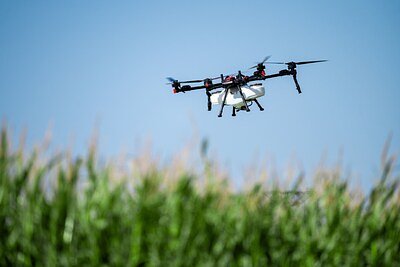
XAG Unveils Next-Gen Farming Tech at Agritechnica, Eyes Global Expansion
Chinese agtech firm XAG showcased its latest robotic and drone innovations at Agritechnica, signaling a push for wider international adoption of precision agriculture and a competitive challenge to industry leaders.
XAG Unveils Next-Gen Farming Tech at Agritechnica, Eyes Global Expansion
Hannover, Germany – November 13, 2025 – Chinese agricultural technology firm XAG unveiled a suite of advanced robotic and drone solutions at Agritechnica, Europe’s leading agricultural trade fair, signaling its ambition to become a major global player in the precision agriculture market. The company’s showcased innovations, including autonomous ground vehicles and upgraded aerial spraying drones, highlight a strategic focus on automation and data-driven farming practices.
Competition Heats Up in the Precision Agriculture Space
The timing of XAG’s expanded presence at Agritechnica comes amidst a surge in investment and innovation in the agricultural technology sector. Global investment in agtech reached record levels in recent years, driven by the need to increase food production while minimizing environmental impact. Industry analysts predict continued growth, with forecasts indicating a multi-billion dollar market for agricultural robots and drones by the end of the decade.
“We are seeing a significant acceleration in the adoption of precision agriculture technologies,” said one industry source. “Farmers are increasingly recognizing the benefits of using data and automation to optimize yields, reduce costs, and improve sustainability.”
XAG’s entry into the European market presents a competitive challenge to established players such as DJI, Trimble, and Yamaha. While these companies have a strong foothold in specific segments of the precision agriculture market, XAG’s integrated approach, combining hardware, software, and data analytics, could differentiate it from the competition.
New Technologies on Display
At Agritechnica, XAG showcased its latest advancements in robotic agriculture. Key among these was a new generation of autonomous ground vehicles designed for weeding, fertilization, and crop inspection. These robots utilize advanced sensors and computer vision to navigate fields, identify weeds, and apply targeted treatments, reducing the need for manual labor and minimizing herbicide use.
The company also highlighted upgrades to its popular line of aerial spraying drones. These drones feature improved flight stability, increased payload capacity, and enhanced spraying precision, allowing farmers to cover larger areas more efficiently and reduce chemical drift. XAG is emphasizing its ability to integrate drone data with ground-based sensor data, offering a comprehensive view of crop health and enabling more informed decision-making.
“The combination of aerial and ground-based robotics offers a powerful solution for farmers,” explained one analyst. “It allows them to monitor crop conditions in real-time, identify problems early on, and take targeted action to address them.”
Expansion Beyond Hardware: A Data-Driven Ecosystem
XAG is not solely focused on hardware development. The company is actively building a comprehensive data platform that integrates data from its robots, drones, and other sources, such as weather stations and soil sensors. This data is then analyzed using advanced algorithms to provide farmers with actionable insights on crop health, irrigation needs, and pest management.
“Data is the key to unlocking the full potential of precision agriculture,” said a company representative. “By providing farmers with the right information at the right time, we can help them make better decisions and improve their bottom line.”
XAG’s data platform also incorporates features such as remote monitoring, predictive analytics, and yield mapping. These features enable farmers to track crop performance, identify areas for improvement, and optimize their farming practices.
Global Ambitions and Market Strategy
XAG’s presence at Agritechnica is part of a broader strategy to expand its global footprint. The company has already established a presence in several countries, including the United States, Australia, and Brazil, and is now targeting the European market.
“Europe is a key market for us,” said a company spokesperson. “We see significant opportunities here, particularly in countries with large agricultural sectors and a strong focus on sustainability.”
XAG’s market strategy involves partnering with local distributors and offering customized solutions tailored to the specific needs of European farmers. The company is also investing in research and development to adapt its technologies to the unique challenges of the European agricultural landscape.
One analyst noted that XAG’s integrated approach could give it an edge in the European market. “European farmers are increasingly demanding comprehensive solutions that address all aspects of their farming operations,” he said. “XAG’s ability to provide both hardware and software, along with data analytics, could be a key differentiator.”
Challenges and Opportunities Ahead
While XAG’s prospects appear promising, the company faces several challenges. Competition in the precision agriculture market is fierce, and XAG will need to continually innovate to stay ahead of the curve. Regulatory hurdles and data privacy concerns could also pose challenges, particularly in Europe.
Another challenge is the need to build trust with European farmers, who may be unfamiliar with XAG’s technologies and business practices. The company will need to demonstrate the value of its solutions and provide excellent customer support to gain acceptance in the market.
Despite these challenges, XAG is well-positioned to capitalize on the growing demand for precision agriculture technologies. The company’s integrated approach, combined with its focus on data analytics and sustainability, could enable it to become a major player in the global agricultural market.
One industry source concluded, “XAG is a company to watch. They are bringing innovative technologies to market and are committed to helping farmers improve their productivity and sustainability.” The company's commitment to an integrated ecosystem of hardware, software, and data analytics signals a shift towards more holistic and data-driven farming practices, potentially reshaping the future of agriculture.
📝 This article is still being updated
Are you a relevant expert who could contribute your opinion or insights to this article? We'd love to hear from you. We will give you full credit for your contribution.
Contribute Your Expertise →